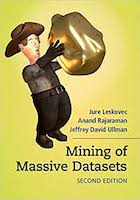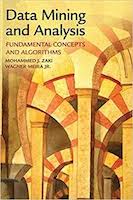Lecturer: Hossein Hajiabolhassan
The Webpage of the Course: Algorithms For Data Science
Data Science Center, Shahid Beheshti University
Index:
Main TextBooks:


-
Mining of Massive Datasets by Jure Leskovec, Anand Rajaraman, and Jeff Ullman.
Reading: Chapter 1, Chapter 2 (Sections: 2.1, 2.2, & 2.3), and Chapter 5
-
Data Mining and Analysis: Fundamental Concepts and Algorithms by Mohammed J. Zaki and Wagner Meira Jr.
Reading: Chapters 13, 14, 15 (Section 15.1), 16, 17, 18, and 19
Slides and Papers
Recommended Slides & Papers:
-
Introduction to Data Science
-
-
-
Introduction to Data Mining
-
MapReduce and the New Software Stack
-
Link Analysis
-
-
Representative-Based Clustering
-
Hierarchical Clustering
-
Density-Based Clustering
-
Spectral and Graph Clustering
-
Clustering Validation
-
Probabilistic Classification
-
Decision Tree Classifier
Additional Slides:
Class time and Location
Saturday and Monday 08:00-09:30 AM (Fall 2018), Room 208.
Grading:
- Homework – 15%
— Will consist of mathematical problems and/or programming assignments.
- Midterm – 35%
- Endterm – 50%
Two Written Exams:
Midterm Examination: Monday 1397/09/12, 08:00-10:00
Final Examination: Sunday 1397/10/16, 08:30-10:30
Prerequisites:
General mathematical sophistication; and a solid understanding of Algorithms, Linear Algebra, and Probability Theory, at the advanced undergraduate or beginning graduate level, or equivalent.
Linear Algebra:
Probability and Statistics:
Topics:
Have a look at some reports of Kaggle or Stanford students (CS224N, CS224D) to get some general inspiration.
Account:
It is necessary to have a GitHub account to share your projects. It offers plans for both private repositories and free accounts. Github is like the hammer in your toolbox, therefore, you need to have it!
Academic Honor Code:
Honesty and integrity are vital elements of the academic works. All your submitted assignments must be entirely your own (or your own group’s).
We will follow the standard of Department of Mathematical Sciences approach:
- You can get help, but you MUST acknowledge the help on the work you hand in
- Failure to acknowledge your sources is a violation of the Honor Code
- You can talk to others about the algorithm(s) to be used to solve a homework problem; as long as you then mention their name(s) on the work you submit
- You should not use code of others or be looking at code of others when you write your own: You can talk to people but have to write your own solution/code
Questions?
I will be having office hours for this course on Monday (09:30 AM–12:00 AM). If this is not convenient, email me at hhaji@sbu.ac.ir or talk to me after class.